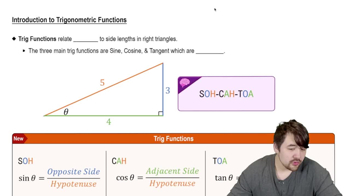Table of contents
- 0. Functions7h 52m
- Introduction to Functions16m
- Piecewise Functions10m
- Properties of Functions9m
- Common Functions1h 8m
- Transformations5m
- Combining Functions27m
- Exponent rules32m
- Exponential Functions28m
- Logarithmic Functions24m
- Properties of Logarithms34m
- Exponential & Logarithmic Equations35m
- Introduction to Trigonometric Functions38m
- Graphs of Trigonometric Functions44m
- Trigonometric Identities47m
- Inverse Trigonometric Functions48m
- 1. Limits and Continuity2h 2m
- 2. Intro to Derivatives1h 33m
- 3. Techniques of Differentiation3h 18m
- 4. Applications of Derivatives2h 38m
- 5. Graphical Applications of Derivatives6h 2m
- 6. Derivatives of Inverse, Exponential, & Logarithmic Functions2h 37m
- 7. Antiderivatives & Indefinite Integrals1h 26m
- 8. Definite Integrals4h 44m
- 9. Graphical Applications of Integrals2h 27m
- 10. Physics Applications of Integrals 2h 22m
4. Applications of Derivatives
Motion Analysis
Problem 3.6.55b
Textbook Question
{Use of Tech} Spring oscillations A spring hangs from the ceiling at equilibrium with a mass attached to its end. Suppose you pull downward on the mass and release it 10 inches below its equilibrium position with an upward push. The distance x (in inches) of the mass from its equilibrium position after t seconds is given by the function x(t) = 10sin t - 10cos t, where x is positive when the mass is above the equilibrium position. <IMAGE>
b. Find dx/dt and interpret the meaning of this derivative.
 Verified step by step guidance
Verified step by step guidance1
To find the derivative dx/dt, we need to differentiate the function x(t) = 10sin(t) - 10cos(t) with respect to t. This involves applying the basic rules of differentiation to each term separately.
Differentiate the first term: The derivative of 10sin(t) with respect to t is 10cos(t). This is because the derivative of sin(t) is cos(t), and the constant 10 remains as a coefficient.
Differentiate the second term: The derivative of -10cos(t) with respect to t is 10sin(t). This is because the derivative of cos(t) is -sin(t), and the constant -10 changes sign to become 10.
Combine the derivatives: The derivative dx/dt is the sum of the derivatives of each term, which gives us dx/dt = 10cos(t) + 10sin(t).
Interpret the meaning: The derivative dx/dt represents the rate of change of the distance x with respect to time t. In the context of the spring oscillation, it indicates the velocity of the mass at any given time t. A positive value of dx/dt means the mass is moving upward, while a negative value means it is moving downward.
 Verified video answer for a similar problem:
Verified video answer for a similar problem:This video solution was recommended by our tutors as helpful for the problem above
Video duration:
3mPlay a video:
Was this helpful?
Key Concepts
Here are the essential concepts you must grasp in order to answer the question correctly.
Derivatives
A derivative represents the rate of change of a function with respect to a variable. In this context, dx/dt indicates how the position of the mass changes over time. It provides insight into the velocity of the mass as it oscillates, showing whether the mass is moving upward or downward at any given moment.
Recommended video:

Derivatives
Trigonometric Functions
The function x(t) = 10sin(t) - 10cos(t) involves sine and cosine, which are fundamental trigonometric functions. These functions describe periodic motion, such as oscillations, and are essential for modeling the behavior of the mass on the spring. Understanding their properties helps in analyzing the motion's amplitude and frequency.
Recommended video:

Introduction to Trigonometric Functions
Equilibrium Position
The equilibrium position is the point where the forces acting on the mass are balanced, resulting in no net force. In this scenario, it is the position where the spring is neither compressed nor stretched. Understanding this concept is crucial for analyzing the oscillatory motion, as it serves as the reference point for measuring displacement and determining the nature of the oscillations.
Recommended video:

Derivatives Applied To Velocity

 6:29m
6:29mWatch next
Master Derivatives Applied To Velocity with a bite sized video explanation from Nick
Start learning



